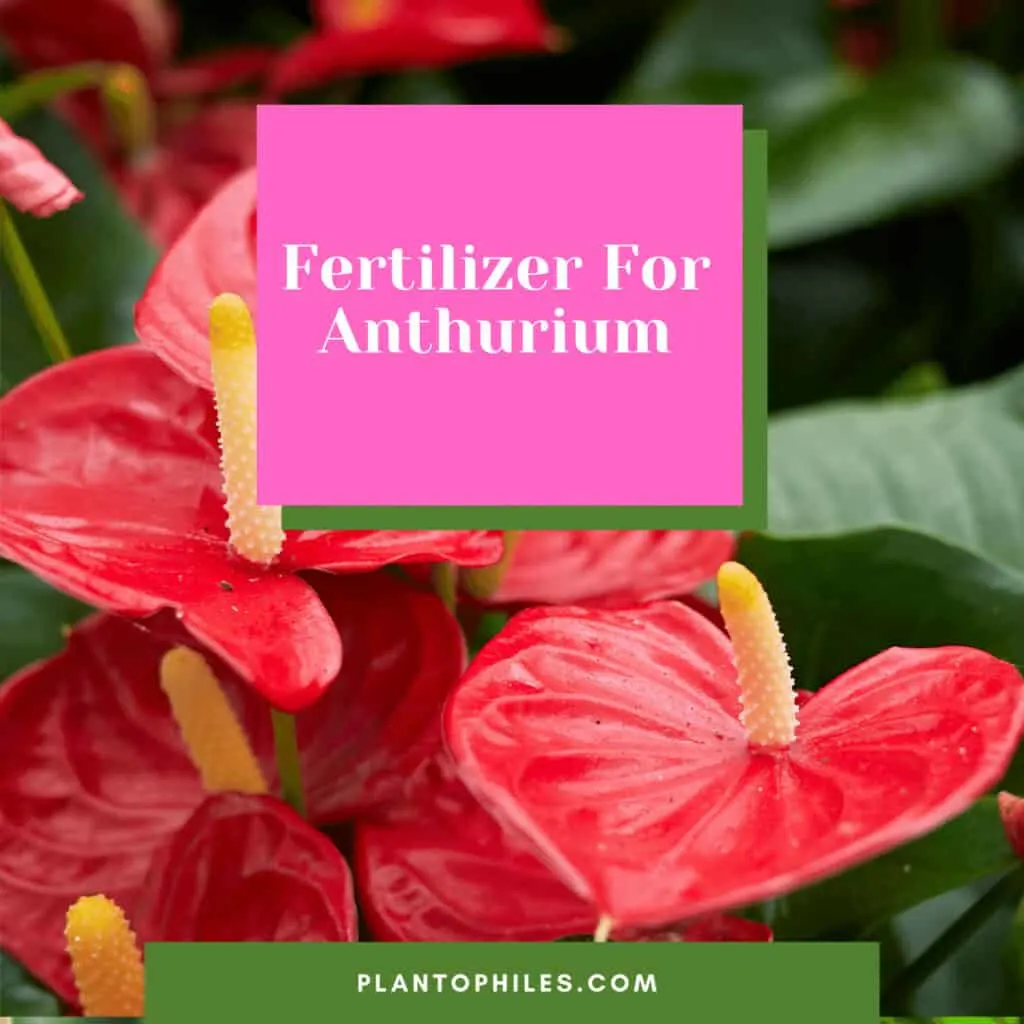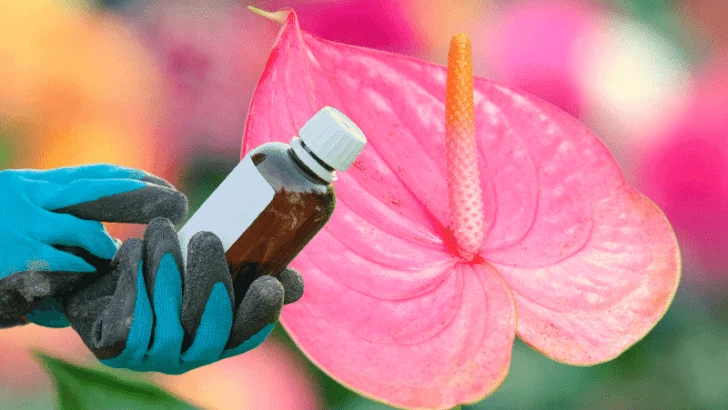The right fertilizer for Anthurium plants is important for them to stay healthy. Developing foliage and blooms is nutrient intensive. In addition, plant growth needs a lot of energy.
Therefore adding fertilizer specifically for indoor plants is vital as the number of nutrients available in potting soil is limited. Overfertilization is harmful as it can burn the leaves and the roots of a plant.
I, therefore, wrote this fertilizer guide for Anthurium plants.
Table of Contents
How and When to Fertilize Anthurium
Anthurium plants should be fertilized twice a month in spring and summer during the main growth phase. Apply a well-balanced fertilizer of NPK 5-10-10 or 10-20-20, or 16-16-16 twice a month. Reduce fertilization in autumn and winter, or stop adding fertilizer altogether.

How to Fertilize Anthuriums
You can fertilize Anthurium plants either by using a liquid fertilizer that has to be applied twice a month or a slow-release fertilizer that you apply once every six months.
It is important to water your plant after applying the fertilizer to avoid root and foliage burn, as the fertilizer can accumulate in the soil.
What Fertilizer to Use
You can distinguish between slow-release fertilizer and liquid fertilizer. Both have their advantages and disadvantages. The most important thing is to use them right, depending on the type of fertilizer your use.
Benefits of Using Slow-Release Fertilizer
A big advantage of using slow-release fertilizer is that it only needs to be applied about once every six months. It is less damaging to the roots and leaves, according to the University of Hawaii.
A disadvantage of using granular fertilizer is that it is hard to know how much fertilizer the plant takes in.
Benefits of Using Liquid Fertilizer
A benefit of liquid Anthurium fertilizer is that you can measure it exactly. It is also taken in faster by the plant.
The major disadvantage is that you are easily overfertilizing your plant. If you add too much fertilizer to the water, it can burn the plant.
When to Fertilize Anthuriums
Fertilize in the growing season twice every four weeks. The growing season generally is between the last frost in spring and the first frost I’m autumn. The season varies depending on where you live.
Best Fertilizer for Anthurium
The best fertilizers for Anthurium plants are:
After looking at the fertilizer for Anthurium, let’s now look at if you need to fertilize Anthurium at all.
Does an Anthurium Need Fertilizer?
Every plant needs nutrients in the soil to grow well. No plant can grow without nutrients. The reason why we apply fertilizer is that the amount of nutrients stored in soil is limited. Each time you water, some of the nutrients, such as nitrogen (N), phosphorus (P), and potassium (K) are flushed away.
Also, after a while, all the nutrients in the potting mix are used. This is why you have to supply potted plants with fertilizer.
Not only will they grow quicker but also more vigorously, providing bigger and more blooms and healthier leaves when done correctly.
What Kind of Fertilizer do Anthuriums Need
A well-balanced fertilizer such as NPK 5-10-10 or 10-20-20 is ideal. So nitrogen (N), phosphorus (P), and potassium (K) are balanced. In addition, add in micronutrients such as calcium (Ca), magnesium (Mg), iron (Fe), and other micronutrients, according to the University of the West Indies.
A study found that flower production in Anthurium andreanum was best when grown outdoors under 75% shade using an NPK fertilizer of 19-19-19, according to the Journal of Applied and Natural Science.
High phosphorus fertilizer for Anthurium plants is used for Flamingo Flowers to get bigger blooms.
The best Homemade Fertilizer for Anthurium
Great homemade fertilizers for Anthuriums are:
- Banana peel
- Compost
- Vermicompost
- Chicken manure
- Cattle manure
In addition to homemade organic fertilizer, you can also rely on synthetic fertilizer. The most important aspect is to use a balanced fertilizer.
Read more about fertilizing Anthurium with worm castings.
Can I use orchid fertilizer on Anthuriums?
As orchid fertilizers are generally balanced, you can use them for Anthuriums. According to the Brooklyn Botanic Garden, 70% of orchids are epiphytes. Most Anthuriums are also epiphytes and thus grow on other trees and objects. It is not surprising that they have similar fertilization needs.
Epiphytic plants take in their nutrient from rain and wind and foliage and debris that lands on trees, crooks and nannies. the concentration and amount of nutrients are lower compared to the soil. This is why you fertilize your Anthurium lightly.
Coffee grounds good for Anthuriums
The debate about whether coffee grounds are good for Anthuriums is still ongoing. A good practice is to use a concentration of 10-20% of the total compost.
Coffee grounds can be used to fertilize your Anthurium, according to Linda Chalker-Scott, Ph.D. The carbon-to-nitrogen ratio can be down to 11:1, considered ideal for plant growth.
Coffee grounds increase the nitrogen in the soil and contain sugars that microbial life, bacteria, and fungi can use. It prevents fungal rots and wilts.
Growers use coffee grounds as a substitute for peat moss. It has water retention properties and also regulates the temperature in the soil.
However, it needs to be said that there is a lot of discussion about the effective pH value of coffee grounds. Some claim it to be alkaline (pH 8.4), others neutral (pH 7.7).
The truth is that the pH value is unstable and changes over time as the coffee ground decomposes in the earth.
Advantages of fertilizing Anthurium
The main benefits are:
- faster growth
- vibrant foliage
- bigger blooms
- stronger roots
- reduces nutrient deficiencies
- better protection against pests
Signs Your Anthurium Plant is Lacking Nutrients
The most common signs your plant is lacking nutrients:
- Slower growth due to a phosphorus deficiency
- Smaller or no blooms
- Smaller leaves
- leaves turn yellow or brown around the edges
- yellowing of new leaves indicating nitrogen deficiency
How to Apply Fertilizer
Step 1: Choose the right fertilizer. A well-balanced fertilizer with an even NPK ratio.
Step 2: Check the package of the fertilizer and apply 1/2 to 1/3 of the recommended strength
Step 3: Add the fertilizer to lukewarm water
Step 4: Water the plant with the dissolved fertilizer using a water can or sprayer
Step 5: Water again to flush away excess fertilizer
Step 6: Fertilize again after 4 weeks
Main Considerations When Fertilizing Anthuriums
One of the most important things to consider is when to fertilize. Do only fertilize when your plant is actively growing during the growing season.
Also, do not apply more than the recommended strength on the packaging. Whenever you fertilize, flush the remaining fertilizer with water so salts are not building up in the potting mix.
The Dangers of Over-Fertilizing Anthuriums
The biggest risk of overfertilization is the accumulation of excess salts in the soil. This can lead to fertilizer or nitrogen burn on roots and foliage. In addition, it can lead to nutrient toxicities. Iron chlorosis, as well as magnesium and potassium toxicity, are often observed.
The result is wiling plants, foliage scorch, stunted root growth, and stem dieback.
Fixing Fertilizer Burn in Anthuriums
Once fertilizer burns are visible on leaves and roots, it is important to remedy the situation. The concentration of nutrients and salts in the soil can be reduced by watering the soil intensely.
A good method is to put the plant in question in the shower and water it heavily. This process is called periodic leaching and should be repeated multiple times. This way, salts, and other contaminations are percolated from the soil.
Frequently Asked Questions
Is Epsom salt good for Anthurium plants?
Epsom salts are good for Anthurium plants. They contain an increased amount of magnesium and sulfur. For plants to take in nitrogen and phosphorus, magnesium sulfate plays an important role. In addition, water retention and soil drainage are also improved. Therefore Epsom salts are great to use.
When should I fertilize my Anthurium plant?
The main growing season between the last frost in spring and before the first frost in autumn should be used to fertilize your plant twice a month. You do not need to fertilize in winter and autumn.
How often should I fertilize my Anthurium Plant?
You should fertilize your Anthurium plant every four weeks in spring and summer. Refrain from fertilizing in autumn and winter when your plant is not actively growing.
Conclusion to Fertilizer For Anthurium
Anthurium plants need fertilizer about twice every four weeks in spring and summer. use 1/2 or 1/3 of the recommended strength, or use slow-release fertilizer about once every six months. Always flush the soil with water after applying it.

Daniel has been a plant enthusiast for over 20 years. He owns hundreds of houseplants and prepares for the chili growing seasons yearly with great anticipation. His favorite plants are plant species in the Araceae family, such as Monstera, Philodendron, and Anthurium. He also loves gardening and is growing hot peppers, tomatoes, and many more vegetables.
Last update on 2025-01-16 / Affiliate links / Images from Amazon Product Advertising API


